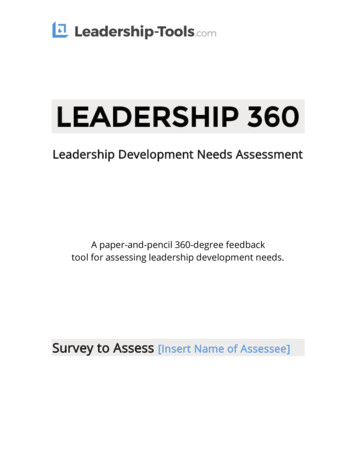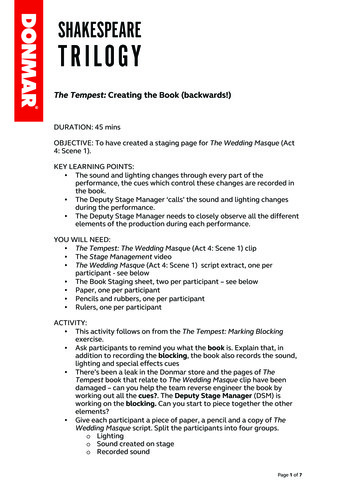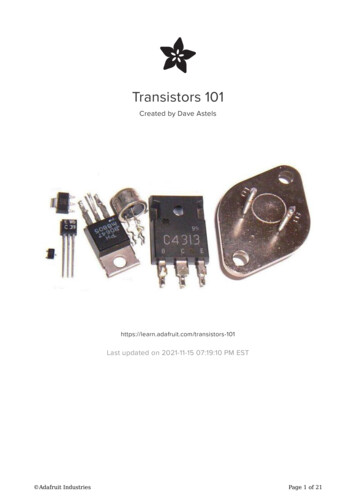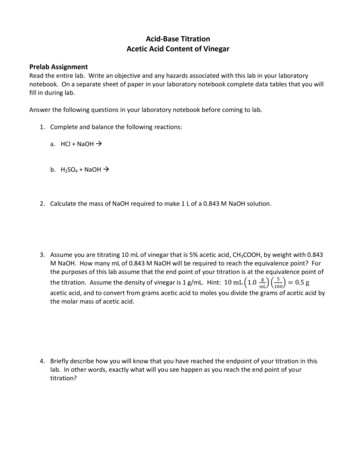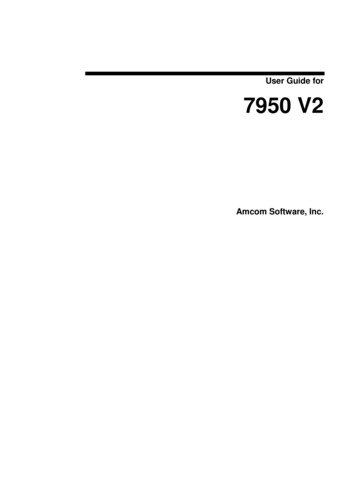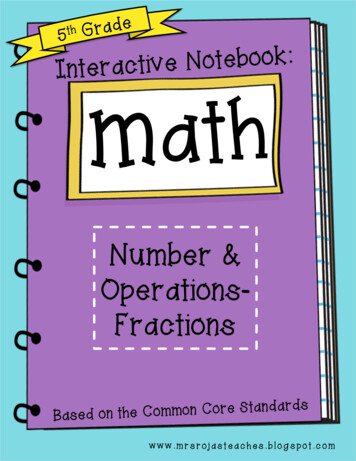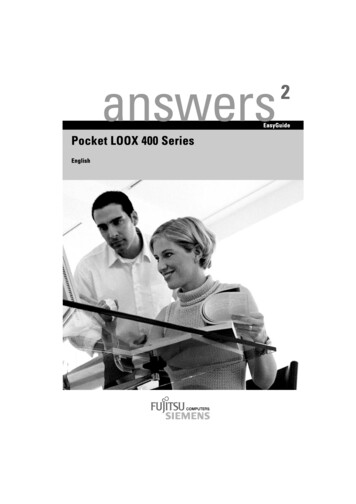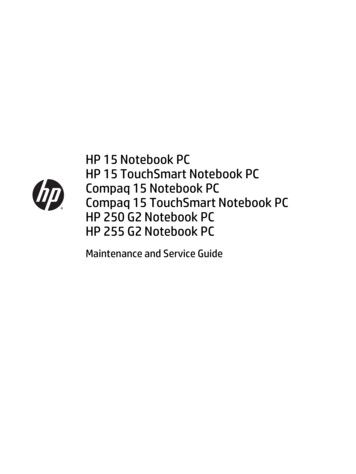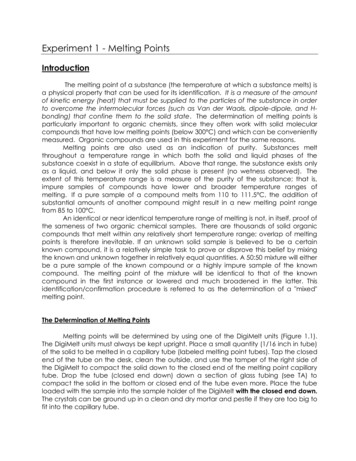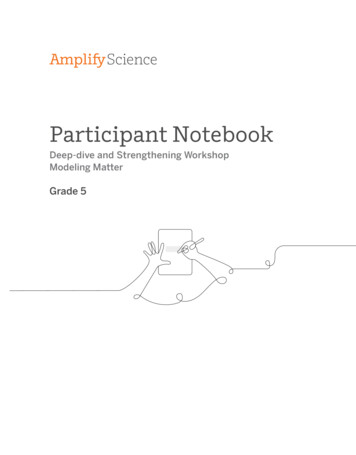
Transcription
Participant NotebookDeep-dive and Strengthening WorkshopModeling MatterGrade 5
Welcome to the workshopThis Participant Notebook will serve as a resource during today’s workshop.Modeling MatterGrade 5 2018 The Regents of the University of CaliforniaGrade 5Modeling MatterParticipant Notebook1
Unit-specific workshop agendaIntroductionsFraming the day Reflecting on our teaching Scenario challengeExperiencing the unit Framing with a coherence lens Modeling Matter instructional sequence and embedded reflectionThe story of the unit Key concepts and explanations Progression of ideas Progress Build and End-of-Unit AssessmentTargeted small group work time: Deepening content understanding and addressing preconceptions Exploring the Modeling Matter Simulation Formative assessment and differentiation Preparing to teachClosing Questions SurveyDemo account for your workshop:URL: learning.amplify.com (Log in with Amplify)Temporary account: @tryamplify.netPassword: AmplifyNumber12Amplify Science 2018 The Regents of the University of California
Table of ContentsNotes . . . . . . . . . . . . . . . . . . . . . . . . . . . . . . . . . . . . . . . .4Reflecting on Amplify Science implementation . . . . . . . . . . . . . .6Self-assessment: How comfortable are you teachingAmplify Science? . . . . . . . . . . . . . . . . . . . . . . . . . . . . . . . . .7Modeling Matter Unit Map . . . . . . . . . . . . . . . . . . . . . . . . . . .8Modeling Matter Coherence Flowchart . . . . . . . . . . . . . . . . . . .10Investigation Notebook pages . . . . . . . . . . . . . . . . . . . . . . . .13Connecting key concepts to chapter explanations . . . . . . . . . . .27Reflecting on the progression of ideas . . . . . . . . . . . . . . . . . . . 28Modeling Matter Progress Build . . . . . . . . . . . . . . . . . . . . . . .29Progress Build and End-of-Unit Assessment . . . . . . . . . . . . . . .30Self-inventory: Choosing an area of focus . . . . . . . . . . . . . . . . . 32Targeted small group work time . . . . . . . . . . . . . . . . . . . . . . . 33i. Deepening content understanding and addressing preconceptions . 34ii. Exploring the Modeling Matter Simulation . . . . . . . . . . . . . . . . 38iii. Formative assessment and differentiation . . . . . . . . . . . . . . .42iv. Preparing to teach . . . . . . . . . . . . . . . . . . . . . . . . . . . . . . 46Three dimensions of NYSSLS reference . . . . . . . . . . . . . . . . . .47Amplify Science support . . . . . . . . . . . . . . . . . . . . . . . . . . . . 48Notes . . . . . . . . . . . . . . . . . . . . . . . . . . . . . . . . . . . . . . . . 2018 The Regents of the University of California49Grade 5Modeling MatterParticipant Notebook3
Notes4Amplify Science 2018 The Regents of the University of California
Notes 2018 The Regents of the University of CaliforniaGrade 5Modeling MatterParticipant Notebook5
Reflecting on Amplify Science implementation1. What was a positive moment from teaching your first unit(s)? What was particularly effective in your classroom?2. What was a challenge you experienced in your first unit(s)? What was an “aha” moment you had while planningor teaching that helped you overcome that challenge?3. A mplify Science uses a multimodal approach — students do, talk, read, write, and visualize as they constructexplanations of phenomena. Describe a time when the multimodal approach helped a particular student orstudents in your classroom.6Amplify Science 2018 The Regents of the University of California
Self-assessment: How comfortable are you teachingAmplify Science?Directions:After each group shares the solution to their scenario, rank your comfort level with the scenario’s category usingthe statements along the top of the table.ScenarioI am startingto understandthisI can do this(with a littlehelp)I’ve got this! Ifeel confidentI can teachthis to a peerScenario 1Using program resources to deepencontent knowledge and find information toanswer content questionsScenario 2Using formative assessment to informinstructionScenario 3Analyzing student work on the End-of-UnitAssessmentScenario 4Understanding the 3-D nature of standardsin the unitScenario 5Understanding how ideas build across achapter and unitScenario 6Preparing to teach a lesson 2018 The Regents of the University of CaliforniaGrade 5Modeling MatterParticipant Notebook7
Modeling MatterUnit MapPlanning for the UnitUnit MapWhat happens when two substances are mixed together?In the role of food scientists working for Good Food Production, Inc., students are introduced to the ideas that all matteris made of particles too small to see and that each different substance is made of particles (molecules) that are unique.Students are then challenged to solve two problems: One problem requires them to separate a mixture, and the otherproblem requires them to make unmixable substances mix. Students are challenged to use the particulate model ofmatter to explain their work to the president of the company. In so doing, students figure out that the properties ofmaterials are related to the properties of the nanoparticles that make up those materials.Chapter 1: Why did the food coloring separate into different dyes?Students figure out: The different dyes that are mixed together have different properties (colors), so they are made ofdifferent molecules. The molecules in the mixture that are carried up the paper by the water are attracted to the waterand mix with it. As the water travels up the paper, different kinds of molecules travel different distances because theirmolecules are different sizes or have a different attraction to the paper.How they figure it out: Students conduct a chromatography test on the dye mixture and observe as it separates. Theclass explores and critiques a variety of physical models before creating their own models of what might be happeningat the nanoscale. Students share, critique, and revise their diagram models and write scientific explanations.Chapter 2: Why do some salad dressings have sediments, and others do not?Students figure out: Salad dressings with sediments contain solids that are not soluble; salad dressings withoutsediments contain soluble solids. The molecules of water and the molecules of different solids are different from oneanother. When a solid dissolves in water (it is soluble), it means that the molecules of the solid are attracted to watermolecules. When a solid does not dissolve in water, it means that the molecules of the solid are not attracted to watermolecules.How they figure it out: Students get hands-on experience with solids that dissolve and solids that do not dissolve. Theythen explore the phenomenon of a solid dissolving at the nanoscale in the Modeling Matter Simulation. Students createtheir own diagram models and write scientific explanations of dissolving.Chapter 3: Why can salad-dressing ingredients separate again after being mixed?Students figure out: When liquids do not mix together, they form layers. The A molecules and the B molecules are notattracted to one another, so they do not mix together. In addition to the level of attraction between A molecules and Bmolecules, A molecules have a level of attraction to other A molecules, and B molecules have a level of attraction toother B molecules. Liquid ingredients in a salad dressing separate after being mixed if the attraction between moleculesof one liquid is greater than the attraction between molecules of different liquids. However, if an emulsifier is added, theliquids can mix because the molecules of the emulsifier are strongly attracted to both A molecules and B molecules.48Amplify Science 2018 The Regents of the University of California
Modeling MatterUnit MapPlanning for the UnitHow they figure it out: Students observe real liquids that don’t mix, and then they use the Simulation to figure outwhat the phenomenon might look like at the nanoscale. Students create their own models of mixing and non-mixingliquids and write scientific explanations about the phenomenon. In order to try to get liquids to mix, students thenexperiment with food additives that act as emulsifiers, and some that do not. The Simulation enables them to exploreand observe how emulsifiers work at the nanoscale and create their own models that explain how emulsifiers work.5 2018 The Regents of the University of CaliforniaGrade 5Modeling MatterParticipant Notebook9
10Amplify ScienceThe different dyes that are mixed together have different properties (colors), so they are made of differentmolecules. The molecules in the mixture that are carried up the paper by the water are attracted to the water andmix with it. As the water travels up the paper, different kinds of molecules travel different distances because theirmolecules are different sizes or have a different attraction to the paper. Different molecules have different properties.(1.5) The properties of a substance are determinedby the properties of its molecules. (1.8) All molecules of one substanceare exactly the same, and they aredifferent from molecules of anyother substance. (1.4)Explanation thatstudents can maketo answer theChapter 1 Question Use and discuss the Fan Model ofchromatography (1.5) Make and evaluate nanovision models ofchromatography first by drawing, then withdigital tool (1.6) Read Break it Down (1.7) Revisit Break it Down to analyze how scientistsfocus on properties of molecules to separatemixtures (1.8) Evaluate example nanovision models ofchromatography (1.8) Observe digital Scale Tool to viewnanoscale objects (1.3) Read Made of Matter (1.3) Use chromatography to separatefood coloring mixture (1.4) Observe the Pasta Model anddiscuss in relation tochromatography (1.4) Write about how molecules canbe similar and different (1.4) Revise nanovision models (1.9) Write explanations to answer the Chapter 1 Question (1.10)Observe andrecord propertiesof food mixtures(1.2)Application of keyconcepts to problemKey conceptsEvidence sourcesand reflectionopportunitiesHow are different kinds ofmolecules different? How aremolecules similar? (1.3-1.4)InvestigationQuestionsHow do differences in molecules causesubstances to separate? (1.5-1.7)Why did the food coloring separate into different dyes? (introduced in 1.5)Chapter 1 QuestionHow are differentsubstancesdifferent? (1.2)How can we help Good Food Production, Inc. solve problems with their products—figuring out if their foodcoloring includes a harmful dye and creating an appealing salad dressing?Problem studentswork to solveModeling Matter: The Chemistry of FoodModeling Matter Coherence Flowchart 2018 The Regents of the University of California
2018 The Regents of the University of CaliforniaSalad dressings with sediments contain solids that are not soluble; salad dressings without sediments containsoluble solids. The molecules of water and the molecules of different solids are different from one another. When asolid dissolves in water (it is soluble), it means that the molecules of the solid are attracted to water molecules.When a solid does not dissolve in water, it means that the molecules of the solid are not attracted to watermolecules.Explanation thatstudents can maketo answer theChapter 2 Question When the molecules of a solid are attracted to the molecules of a liquid,they spread apart and mix together evenly. (2.4) When the molecules of a solid aren’t attracted to the molecules of aliquid, they stay clustered together as a solid. (2.4) Some solids dissolve in water,and others do not. (2.1) Write explanations about which flavor ingredients won’t leave sediments in the salad dressing (2.4) Read about sugar and citric acid in Food Scientist’s Handbook (2.5) Use the Sim to investigate connection between molecular attraction and how well two substances mix (2.5) Evaluate explanations of dissolving (2.5) Use the Solubility Mode of the Sim to create a nanovision model of asolid dissolving in a liquid and a solid NOT dissolving in a liquid (2.2) Read and discuss Solving Dissolving (2.3) Discuss nanoscale models of dissolving from the Sim and from SolvingDissolving (2.4) Make digital nanovision models of a soluble substance and an insolublesubstance (2.4) Investigate flavor ingredients forsalad dressing to test forsediments and flavor (2.1) Discuss why some solids leavesediments and others don’t (2.1)What happens to the molecules of a solid and the molecules of a liquidwhen you mix them together? (2.2-2.5)Application of keyconcepts to problemKey conceptsEvidence sourcesand reflectionopportunitiesWhat happens when you mix asolid into a liquid? (2.1)Why do some salad dressings have sediments, and others do not?Chapter 2 QuestionInvestigationQuestionsHow can we help Good Food Production, Inc. solve problems with their products—figuring out if their foodcoloring includes a harmful dye and creating an appealing salad dressing?Problem studentswork to solveModeling Matter: The Chemistry of FoodModeling Matter Coherence Flowchart cont.Grade 5Modeling MatterParticipant Notebook11
12Amplify ScienceWhen liquids do not mix together, they form layers. The A molecules and the B molecules are not attracted to one another,so they do not mix together. In addition to the level of attraction between A molecules and B molecules, A molecules have alevel of attraction to other A molecules, and B molecules have a level of attraction to other B molecules. Liquid ingredientsin a salad dressing separate after being mixed if the attraction between molecules of one liquid is greater than theattraction between molecules of different liquids. However, if an emulsifier is added, the liquids can mix because themolecules of the emulsifier are strongly attracted to both A molecules and B molecules. Molecules of an emulsifier attract themolecules of two liquids that do nottypically mix, allowing the molecules ofthe emulsifier and of the liquids to mix.(3.6)Explanationthat studentscan make toanswer theChapter 3Question The more a liquid’s molecules areattracted to one another, the more theliquid will hold together. (3.3) When the molecules of two differentliquids are attracted to one another, theycluster together and become evenlydistributed in the mixture. (3.3) Some liquid mixturesstay mixed, and othersseparate into layers overtime. (3.1) Some liquids holdtogether more thanothers. (3.1) Investigate possible emulsifiers tocreate stable salad dressing (3.4) Discuss how emulsifiers help liquidsmix at the nanoscale (3.5) Draw nanovision models ofemulsification (3.5) Use the Sim to model liquids that onlystay mixed with the addition of anemulsifier (3.5) Make and evaluate digital nanovisionmodels of emulsification (3.6) Evaluate two example nanovisionmodels of how emulsifiers work (3.6)Why does adding an emulsifier allowtwo liquids that don’t typically mix tostay mixed? (3.5-3.6) Review evidence for how emulsifiers help a salad dressing stay mixed (3.7) Write explanations about why oil and vinegar separate into layers when they are stirred together, but completely mix whenlecithin is stirred in (3.7) Use the All Aboard Model of attractionbetween molecules of a substance (3.1) Read Science You Can’t See (3.2) Discuss and write about what happensto the molecules of two liquids when youmix them (3.3) Use the Sim to investigate howattraction between molecules (of thesame kind and of different kinds) affectsmixing (3.3) Revisit the All Aboard Model, adding asecond substance (3.3)What happens to the molecules of twoliquids when you mix them together?(3.1-3.4) Observe demonstrationof two liquids that staymixed and two thatseparate into layers (3.1) Investigate attractionbetween molecules of thesame kind by seeing howmany drops of the liquidfit on a penny and whatshape they make (3.1)What happens when youmix a liquid into a liquid?(3.1)Why can salad-dressing ingredients separate again after being mixed?How can we help Good Food Production, Inc. solve problems with their products—figuring out if their foodcoloring includes a harmful dye and creating an appealing salad dressing?Modeling Matter: The Chemistry of FoodApplication ofkey conceptsto problemKey conceptsEvidencesources apter 3QuestionProblemstudents workto solveModeling Matter Coherence Flowchart cont. 2018 The Regents of the University of California
Modeling Matter:The Chemistry of FoodInvestigation Notebook 2018 The Regents of the University of CaliforniaGrade 5Modeling MatterParticipant Notebook13
Name: Date:Using Chromatography to Separate a Mixture1. Draw a pencil line. On the paper strip, draw a pencil line along the topedge of the food coloring.2. Attach the paper strip so it hangs in the water, but the food coloringis still above the water. Tape the top of the paper strip to a pencil. Thebottom of the paper strip should just touch the water in the cup, and thefood coloring should remain above the water.3. Start the chromatography test by hanging the paper strip in the water.Place the pencil across the top of the cup.chromatography paperpencil linefood coloringwater9Modeling Matter—Lesson 1.4 2018 The Regents of the University of California. All rights reserved. Permission granted to photocopy for classroom use.14Amplify Science 2018 The Regents of the University of California
Name: Date:Nanovision Model of Chromatography1. Draw what you think happened with the water molecules and themolecules in the food-coloring dyes during chromatography.2. Include a key that will help another scientist understand your model.3. Label the parts of your model.4. Use arrows if needed.pencil line14Modeling Matter—Lesson 1.6 2018 The Regents of the University of California. All rights reserved. Permission granted to photocopy for classroom use. 2018 The Regents of the University of CaliforniaGrade 5Modeling MatterParticipant Notebook15
Name: Date:Getting Ready to Read:Break It Down: How Scientists Separate Mixtures1. Before reading the book Break It Down, read the sentences below.2. If you agree with the sentence, write an “A” on the line before thesentence.3. If you disagree with the sentence, write a “D” on the line before thesentence.4. After you read the book, see if your ideas have changed. Be ready toexplain your thinking.Most things are mixtures.Chromatography is the only way to separate a mixture ofdifferent kinds of molecules.One way that scientists separate some mixtures is to spinthe mixtures very fast.Air is a mixture.Scientists use the properties of molecules to separate mixtures.17Modeling Matter—Lesson 1.7 (optional) 2018 The Regents of the University of California. All rights reserved. Permission granted to photocopy for classroom use.16Amplify Science 2018 The Regents of the University of California
Name: Date:Making Inferences inBreak It Down: How Scientists Separate MixturesRecord in the table below as you read Break It Down. Use the images,captions, and text in the book to help you make inferencesSectionin bookMake an inference toanswer a questionBreak It Downto SolveProblems:pages 10–11In ocean water, arewater moleculesattracted to the atomsthat make up salt?YesNoBreak It Downto Save Lives:pages 12–15Are there different kindsof molecules in blood?Break It Downto Uncoverthe Past:pages 16–21Are the differentmolecules in goat meat,lentils, honey, wine, andolive oil all the same size?YesYesMixtures andProperties:pages 22–23What helped you make theinference? what you already know which image, caption, ortext? (Include page.)NoNoWhat properties ofmolecules might you beable to use to separatepollution from othersubstances?Answer:18Modeling Matter—Lesson 1.7 2018 The Regents of the University of California. All rights reserved. Permission granted to photocopy for classroom use. 2018 The Regents of the University of CaliforniaGrade 5Modeling MatterParticipant Notebook17
Name: Date:Reading Reflection:Break It Down: How Scientists Separate MixturesIf you were a scientist trying to separate pollution molecules from the air,how might you do it? (This question appears on page 23 of Break It Down.)Make a drawing to explain your ideas. Label your drawing.19Modeling Matter—Lesson 1.7 (optional) 2018 The Regents of the University of California. All rights reserved. Permission granted to photocopy for classroom use.18Amplify Science 2018 The Regents of the University of California
Name: Date:Color-Changing Model1. Read the explanation for this model below and review the diagramof the model on the next page.2. Turn to pages 28–29, Evaluating Chromatography Models, and discusseach question with your partner. On page 28, circle Yes or No for each question to indicate if it doesor does not explain what you observed in chromatography andwhat you know about molecules.What happened to the dye and water molecules during chromatography?The water molecules were attracted to the paper molecules, so the watermolecules climbed up the paper.As they passed through the food-coloring mixture, the water moleculesbumped into the dye molecules, and the water molecules changed tothe same colors as the dye molecules. The colored water molecules kepttraveling up the paper.The blue water molecules are the lightest, so they went the farthest. Thered water molecules are the heaviest, so they did not go as far.22Modeling Matter—Lesson 1.8 2018 The Regents of the University of California. All rights reserved. Permission granted to photocopy for classroom use. 2018 The Regents of the University of CaliforniaGrade 5Modeling MatterParticipant Notebook19
Name: Date:Color-Changing Model (continued)Keywater moleculeyellow dye moleculeblue dye moleculered dye moleculepencil line23Modeling Matter—Lesson 1.8 2018 The Regents of the University of California. All rights reserved. Permission granted to photocopy for classroom use.20Amplify Science 2018 The Regents of the University of California
Name: Date:Growing Model1. Read the explanation for this model below and review the diagramof the model on the next page.2. Turn to pages 28–29, Evaluating Chromatography Models, and discusseach question with your partner. On page 29, circle Yes or No for each question to indicate if it doesor does not explain what you observed in chromatography andwhat you know about molecules.What happened to the dye and water molecules during chromatography?The water molecules were attracted to the paper molecules, so the watermolecules climbed up the paper.As the water molecules passed through the food coloring, they attachedto the dye molecules and made the dye molecules grow, so the dye traveledup the paper.The molecules of blue dye grew the most, so they went the highest. Themolecules of red dye grew less, so they did not go as high.24Modeling Matter—Lesson 1.8 2018 The Regents of the University of California. All rights reserved. Permission granted to photocopy for classroom use. 2018 The Regents of the University of CaliforniaGrade 5Modeling MatterParticipant Notebook21
Name: Date:Growing Model (continued)Keywater moleculeyellow dye moleculeblue dye moleculered dye moleculepencil line25Modeling Matter—Lesson 1.8 2018 The Regents of the University of California. All rights reserved. Permission granted to photocopy for classroom use.22Amplify Science 2018 The Regents of the University of California
Name: Date:Attraction Model1. Read the explanation for this model below and review the diagramof the model on the next page.2. Turn to pages 28–29, Evaluating Chromatography Models, and discusseach question with your partner. On page 29, circle Yes or No for each question to indicate if it doesor does not explain what you observed in chromatography andwhat you know about molecules.What happened to the dye and water molecules during chromatography?The water molecules were attracted to the paper molecules, so the watermolecules climbed up the paper.The dye molecules were also attracted to the water molecules. Since theywere attracted to the water molecules, the dye molecules got carried up thepaper. At some point, the dye molecules were more attracted to the papermolecules than to the water molecules, so they stopped moving up.26Modeling Matter—Lesson 1.8 2018 The Regents of the University of California. All rights reserved. Permission granted to photocopy for classroom use. 2018 The Regents of the University of CaliforniaGrade 5Modeling MatterParticipant Notebook23
Name: Date:Attraction Model (continued)Keywater moleculeyellow dye moleculeblue dye moleculered dye moleculepencil line27Modeling Matter—Lesson 1.8 2018 The Regents of the University of California. All rights reserved. Permission granted to photocopy for classroom use.24Amplify Science 2018 The Regents of the University of California
Name: Date:Evaluating Chromatography Models1. Evaluate the three models on pages 22–27.2. In the table for each model, circle Yes or No to indicate if the modelexplains or does not explain what you observed in chromatography andwhat you know about molecules.Everything we know about molecules:Statement A: All molecules of one substance are exactly the same, and theyare different from molecules of any other substance.Statement B: The properties of the molecules of a substance do not change.Color-Changing Model1. Does the model explain how the water traveled up thepaper?YesNo2. Does the model explain how the colors moved up the paper? YesNo3. Does the model explain why some colors went higher?YesNo4. Does the model fit with everything we know aboutmolecules? If not, with which statement(s) does it conflict?StatementYesNo28Modeling Matter—Lesson 1.8 2018 The Regents of the University of California. All rights reserved. Permission granted to photocopy for classroom use. 2018 The Regents of the University of CaliforniaGrade 5Modeling MatterParticipant Notebook25
Name: Date:Evaluating Chromatography Models (continued)Growing Model1. Does the model explain how the water traveled up thepaper?YesNo2. Does the model explain how the colors moved up the paper? YesNo3. Does the model explain why some colors went higher?YesNo4. Does the model fit with everything we know aboutmolecules? If not, with which statement(s) does it conflict?StatementYesNoYesNo2. Does the model explain how the colors moved up the paper? YesNo3. Does the model explain why some colors went higher?YesNo4. Does the model fit with everything we know aboutmolecules? If not, with which statement(s) does it conflict?StatementYesNoAttraction Model1. Does the model explain how the water traveled up thepaper?29Modeling Matter—Lesson 1.8 2018 The Regents of the University of California. All rights reserved. Permission granted to photocopy for classroom use.26Amplify Science 2018 The Regents of the University of California
Connecting key concepts to chapter explanationsModeling MatterDirections:1. For each chapter, read the key concepts, then the explanation.2. With a partner, discuss how the key concepts connect to the explanation.3. Make annotations about the connections.ChKey conceptsExplanation1All molecules of one substance are exactlythe same, and they are different frommolecules of any other substance. (1.4)The different dyes that are mixed togetherhave different properties (colors), so theyare made of different molecules. Themolecules in the mixture that are carried upthe paper by the water are attracted to thewater and mix with it. As the water travels upthe paper, different kinds of molecules traveldifferent distances because their moleculesare different sizes or have a differentattraction to the paper.Different molecules have differentproperties. (1.5)The properties of a substance aredetermined by the properties of itsmolecules. (1.8)2Some solids dissolve in water, and othersdo not. (2.1)When the molecules of a solid areattracted to the molecules of a liquid, theyspread apart and mix together evenly. (2.4)When the molecules of a solid aren’tattracted to the molecules of a liquid, theystay clustered together as a solid. (2.4)3Some liquid mixtures stay mixed, andothers separate into layers over time. (3.1)Some liquids hold together more thanothers. (3.1)The more a liquid’s molecules are attractedto one another, the more the liquid will holdtogether. (3.3)When the molecules of two different liquidsare attracted to one another, they clustertogether and become evenly distributed inthe mixture. (3.3)Molecules of an emulsifier attract themolecules of two liquids that do nottypically mix, allowing the molecules of theemulsifier and of the liquids to mix. (3.6) 2018 The Regents of the University of CaliforniaSalad dressings with sediments containsolids that are not soluble; salad dressingswithout sediments contain soluble solids.The molecules of water and the molecules ofdifferent solids are different from one another.When a solid dissolves in water(it is soluble), it means that the moleculesof the solid are attracted to water molecules.When a solid does not dissolve in water, itmeans that the molecules of the solid are notattracted to water molecules.When liqui
Amplify Science uses a multimodal approach — students do, talk, read, write, and visualize as they construct explanations of phenomena. Describe a time when the multimodal approach helped a particular student or . In the role of food scientists working for Good Food Production, Inc., students are introduced to the ideas that all matter
